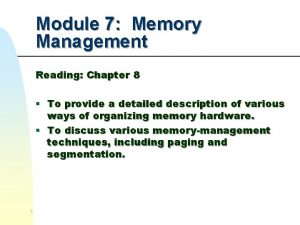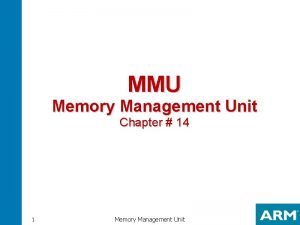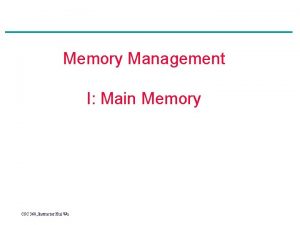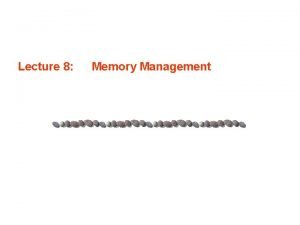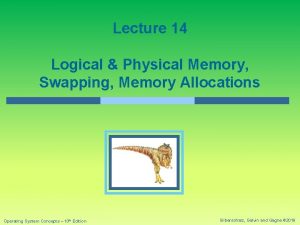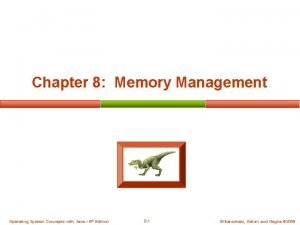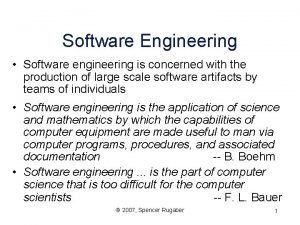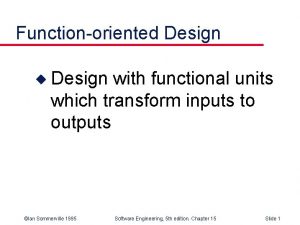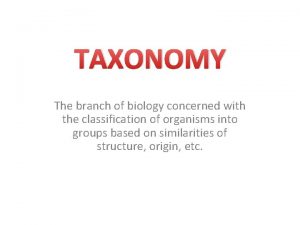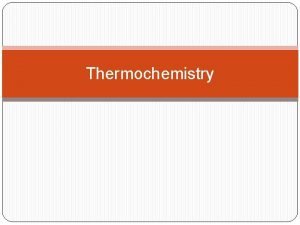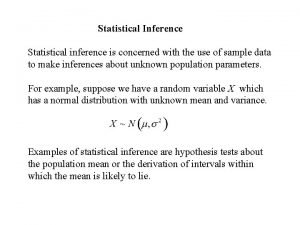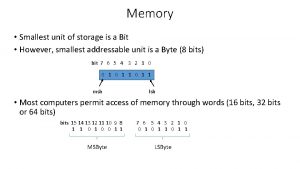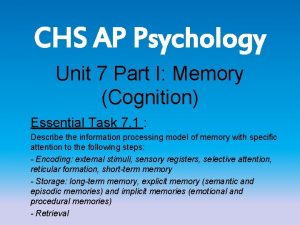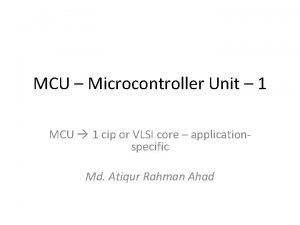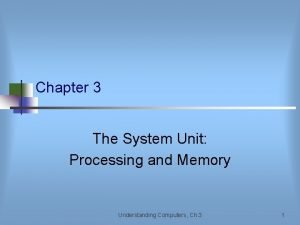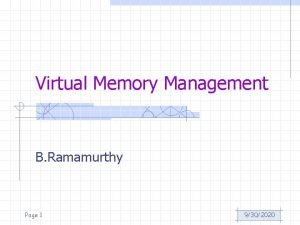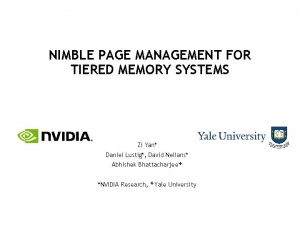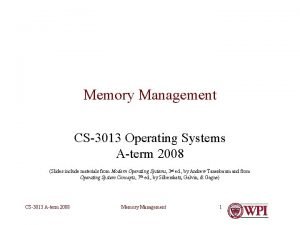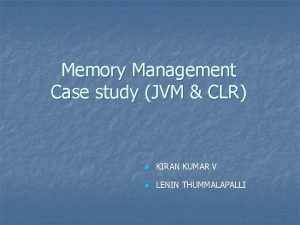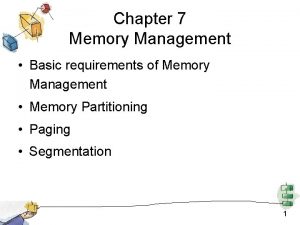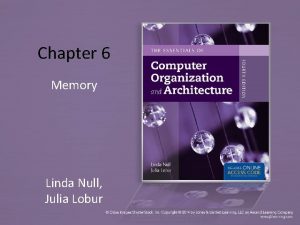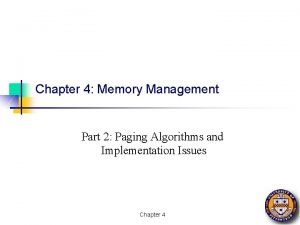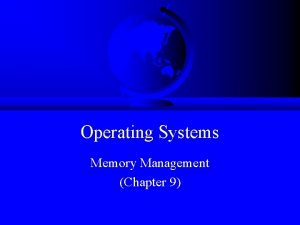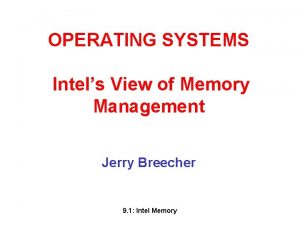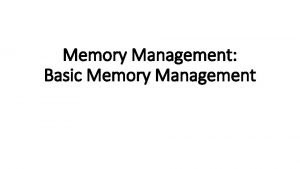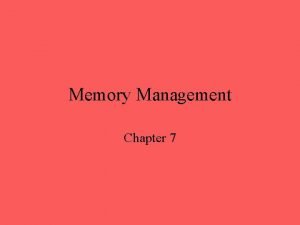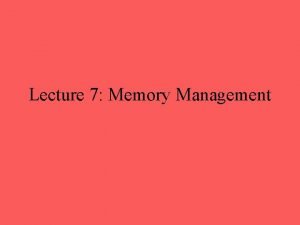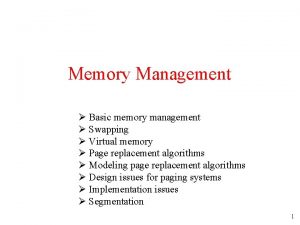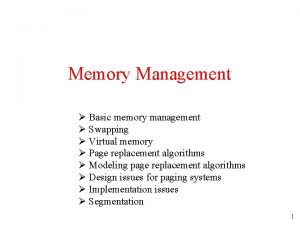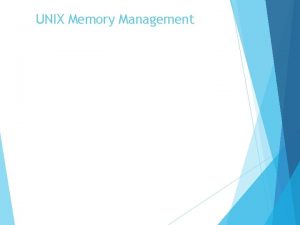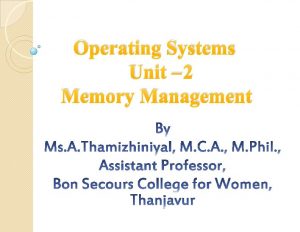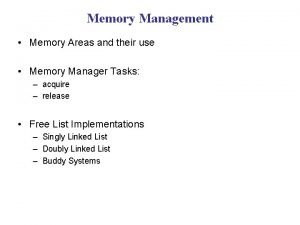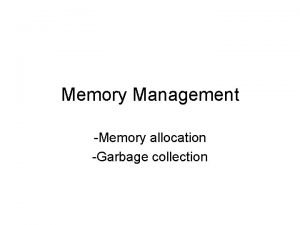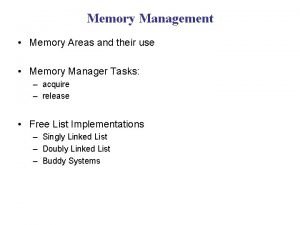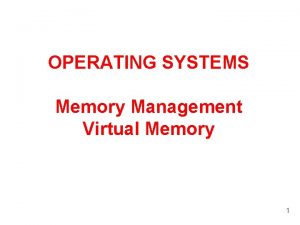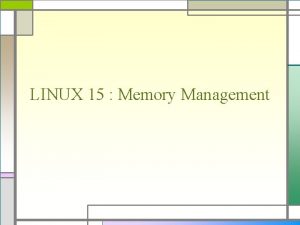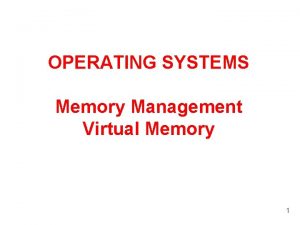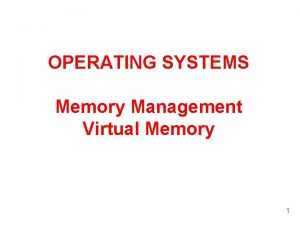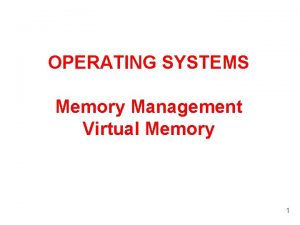Unit II Memory Management Memory Management MM Concerned








































































- Slides: 72

Unit – II – Memory Management

Memory Management (MM) • Concerned with management of primary memory • Four functions of Memory management • Keeping track of the status of each location of primary memory, i. e. , each location is either allocated or unallocated • Determining allocation policy for memory, i. e. , deciding to whom it should go, how much, when, and where. • Allocation technique – once it is decided to allocate memory, the specific locations must be selected and allocation information updated. • Deallocation technique and policy – handling the reclaiming of memory.

Different Techniques of MM • • Single Contiguous MM Partitioned MM Relocation partitioned MM Paged MM Demand Paged MM Segmented and Demand paged MM Other MM Schemes

Four sections of MM techniques • An overview of the approach and concepts employed • A description of any special hardware facilities required or recommended. • A description of the particular software algorithms and processing required • A discussion of the advantages and disadvantages of the particular strategy

Single Contiguous MM • Small stand-alone computer with simple batch OS • No multiprogramming • One-to-one correspondence exists between a user, a job step and a process. • Only one job will be used • Memory is allocated to the job

Single Contiguous MM… OS User area Free Area Single Contiguous allocation in a memory

Single Contiguous MM… • Functions • Keeping track of memory – it is allocated entirely to one job • Determining factor on memory policy – the job gets all memory when scheduled. • Allocation of memory - all of it is allocated to the job. • Deallocation of memory – when the job is done, all memory is returned to free status.

Single Contiguous MM… • Hardware Support – • No special hardware is required for contiguous allocation. • Sometimes primitive hardware protection mechanism is desirable to ensure that the user’s program do not accidentally or maliciously tamper with the OS. • It consists of bounds register – contains the address of the protected area.

Single Contiguous MM… • Software Support Enter Is required job size <= available memory Yes Assign Memory to job Load and execute Job finished deallocate memory and find another job to run No Job cannot be run – error condition, try another job

Single Contiguous MM… • Advantages – • Simplicity • It does not require great expertise to understand the system. • Disadvantages – • Memory is not fully utilized • Poor utilization of Memory, CPU and I/O channel and I/O devices. • Lack of flexibility • User’s job size is limited to the size of available memory.

Introduction to multiprogramming • Keeping more than one job at a time on memory – distribute the resources among these jobs – multiprogramming, is a interleaved or concurrent execution of two or more processes. • Examples of Multiprogramming : • Job 1(30 K) – Compute C 1 – I/O I 1 • Job 2(50 K) – Compute C 2 – I/O I 2 • Job 3(20 K) – Compute C 3 – I/O I 3

Introduction to multiprogramming… I 1<=C 2+C 3 Processor waiting time : I 1 -(C 2+C 3) The processor utilization is higher in multiprogramming Measures of System I/O Wait percentage. The computation and I/O are intermingled in complex ways. • A useful aggregate parameter is the job’s percentage of I/O wait time, ω, which equals • Total I/O wait time total I/O plus total CPU time • • •

Introduction to multiprogramming… • If we have two jobs each with ω=50%, and they are multiprogrammed is the effective system I/O wait percentage ω’, reduced to zero? • If C 1=I 1=C 2=I 2, then C 2 will be executed concurrently with I 1

Introduction to multiprogramming…

Introduction to multiprogramming… • If we have n processes, each with same I/O wait percentage , ω, the system I/O wait percentage ω’ is approximately by ω’= ωn. • For example if ω=50% then No. of Processes N System I/O wait percentage 1 (. 50)1=50% 2 (. 50)2=25% 3 (. 50)3=12. 5% 4 (. 50)4=6. 3% 5 (. 50)5=3. 1% 6 (. 50)6=1. 6%

Introduction to multiprogramming… • System I/O wait percentage is

Partitioned Allocation • Main memory is divided into number of memory regions or memory partitions • Each partition holds a separate job’s address space is shown in the following figure

Partitioned Allocation…

Partitioned Allocation… • Function of partition MM • Keeping track of the status of each partition (eg. “in use” or “not in use”, size) • Determining who gets memory – this is handled largely by the job scheduler. • Allocation – an available partition of sufficient size is assigned • Deallocation – when the job terminates, the partition is indicated “not in use” and is available for future allocation.

Partitioned Allocation… • Hardware Support • Little special hardware is needed • Two bounds register to bracket the partition being used Disadantage : 1. the bounds registers must be changed every time that the processor is reassigned for multiprogramming, 2. it is difficult to extend this protection to the I/O channel, In multiplexor channels required more bounds register • In IBM 370 used protection key with each block of memory (1 through 15) key 0 for OS

Partitioned Allocation… • Software Algorithm – Static Partition specification – Dynamic Partition specification

Operating Systems – 7

Partitioned Allocation • Main memory is divided into number of memory regions or memory partitions • Each partition holds a separate job’s address space is shown in the following figure

Partitioned Allocation…

Partitioned Allocation… • Function of partition MM • Keeping track of the status of each partition (eg. “in use” or “not in use”, size) • Determining who gets memory – this is handled largely by the job scheduler. • Allocation – an available partition of sufficient size is assigned • Deallocation – when the job terminates, the partition is indicated “not in use” and is available for future allocation.

Partitioned Allocation… • Hardware Support • Little special hardware is needed • Two bounds register to bracket the partition being used Disadantage : 1. the bounds registers must be changed every time that the processor is reassigned for multiprogramming, 2. it is difficult to extend this protection to the I/O channel, In multiplexor channels required more bounds register • In IBM 370 used protection key with each block of memory (1 through 15) key 0 for OS

Partitioned Allocation… • Software Algorithm – Static Partition specification – Dynamic Partition specification • Static Partition Specification : Memory is divided into partition prior to the processing of any jobs. The partition specification may be designated by the computer operator or it may be built into the OS.

Partitioned Allocation… • Static partition specification table Partition number Size Location Status 1 8 K 312 K IN USE 2 32 K 320 K IN USE 3 32 K 352 K NOT IN USE 4 120 K 384 K NOT IN USE 5 520 K 504 K IN USE

Partitioned Allocation… • When size and frequency of jobs are well known. The partition sizes are chosen to correspond closely to the most common job sizes. Partition number Size Job Size Wasted Space 1 8 K 1 K 7 K 2 32 K 9 K 23 K 3 32 K 9 K 23 K 4 120 K 33 K 87 K 5 520 K 121 K 399 K Total 712 K 173 K 539 K

Partitioned Allocation… • Dynamic Partition Specification: • Partitions are created during job processing so as to match partition sizes to job sizes. The technique have been called partitioned memory, dynamic storage allocation, controlled storage and garbage collection. • Two tables required to do dynamic partition – Allocated Partition Status table – Unallocated Area Status table

Partitioned Allocation… • Allocated Partition Status Table Partition Number Size Location Status 1 8 K 312 K ALLOCATED 2 32 K 320 K ALLOCATED 3 - - EMPTY ENTRY 4 120 K 384 K ALLOCATED 5 - - EMPTY ENTRY

Partitioned Allocation… • Unallocated Area Status table Free Area Size Location Status 1 32 K 352 K AVAILABLE 2 520 K 504 K AVAILABLE 3 - - EMPTY ENTRY 4 - - EMPTY ENTRY - -

Partitioned Allocation…

Partitioned Allocation…

Partitioned Allocation… • Two partition allocation schemes – First fit – Best fit • First Fit Partition Algorithm : In this the free table is kept sorted by location, we start at the free area at the lowest memory address and keep looking until we find the first free area big enough for the partition to fit. • 2 major advantages, 1. Is partition adjacent to any free area? in the deallocation algorithm usually searching half the table, here lower memory location so always found first. 2. it favours using the free areas at low memory address • When a very large partition size is needed, there is a good chance of finding a large enough free area.

Partitioned Allocation… • Best fit partition algorithm • The free table is kept sorted by size ( i. e. , the first entry corresponds to the free area with smaller size) • The first free area we find that is large enough for the desired partition is best fit. • 3 advantages – 1. on the average the best fit area can be found by searching only half the table. • 2. If there is a free area of exactly the desired size, it will be selected, • 3. If there is no free area of exactly the desired size, the partition is carved out of the smallest possible free area and does not destroy a large free area.

Partitioned Allocation… • Disadvantage is that the free area is not exactly right size and must be split it into two pieces, due to the best fit criteria, the resulting free area is often quite small – so small that it may be almost worthless

Partitioned Allocation…

Partitioned Allocation… • Fragmentation Problem: free memory area unable to utilize because of smaller in size scattered around the memory is called fragment. The development of a large number of separate free areas is fragmentation problem. • Fragmentation problem may be rectified to move the free areas together with other techniques.

Partitioned Allocation… • Multiple partition algorithm : this technique sometimes decrease the fragmentation problem. The Job require 100 K of memory may actually consists of five 20 K portions. The Job can be allocated either one 100 K partition, or five 20 K partitions or two 40 K and one 20 K partition and so on. This approach is called multiple partition allocation.

Partitioned Allocation… • Advantages- It facilitates multiprogramming, hence, more efficient utilization of the processor and I/O devices. • It requires no special costly hardware. • The algorithms used are simple and easy to implement. • Disadvantages : Fragmentation problem leads to under utilization of memory • Job size is limited to the memory size. • It does require more memory than a single contiguous allocation

Operating Systems - 8 Relocatable Partitioned Memory Management

Relocatable Partitioned Memory Management • The fragmentation problem is to periodically combine all free areas into one contiguous area. • This can be done by moving the contents of allocated partitions so that they become contiguous. • This process is called compaction or recompaction or burping

Relocatable Partitioned Memory Management…

Relocatable Partitioned Memory Management… • Moving a job’s partition doesn’t quarantee that the job will still run correctly at its new location. • This is because there are many location sensitive items such as • 1). Base registers, • 2). Memory referencing instructions, • 3). Parameter lists and • 4). Data structures ( eg. Lists, chains, stacks, queues etc. ) that use address pointers. • To operate correctly, all location sensitive items must be suitably modified. Eg. Job 4 moved from 352 K to 320 K, all address must be decreased by 32 K.

Relocatable Partitioned Memory Management… • Another possible solution exists to the relocation problem could reload all jobs to be relocated and restart them from the beginning. • Several hardware techniques have been developed to cope with this relocation problem. • – concept of mapped memory: the address space “seen” by a job is not necessarily the same as the physical memory address used. This concept is sometimes called virtual memory. • Except for the process of compaction and relocation, this scheme is very similar to the partition allocation scheme.

Relocatable Partitioned Memory Management… • Hardware Support: • There are two common approaches to the relocation problem, both of which require special hardware support. • One approach based upon the data typing concept, physically records the type of value stored in every memory location. - 2 bits to every word to designate the value type: 00 -integer, 01 -floating number, 10 - Character, 11 - address pointer. A=B, not only sets A to the value of B but also copies the type information. The extra bits in compaction may be slow because of the each word to be examined. • Another common hardware solution uses dynamic relocation by means of base-bounds relocation registers. Two special privileged registers, the base relocation register and the bounds register are accessible only by the operating system. • On every memory reference, the content of the base relocation register is automatically added to the effective address. The effective address is the final reference address computed by the processor.

Relocatable Partitioned Memory Management…

Relocatable Partitioned Memory Management… • The relocation adjustment is done automatically as each instruction is executed, it is called dynamic relocation. • Protection – locks and keys. • More commonly a bounds register is set to the maximum address in the job’s address space.

Relocatable Partitioned Memory Management… • Software Algorithm:

Relocatable Partitioned Memory Management…

Relocatable Partitioned Memory Management… • • Advantages: It eliminates fragmentation High degree of multiprogramming It results in increased memory, Processor and I/O devices utilization.

Relocatable Partitioned Memory Management… • Disadvantages: • Relocation hardware increases the cost of the computers and may slow down the speed. • Compaction time may be substantial. • Some memory will still be unused because even though it is compacted, the amount of free area may be less than the needed partition size. • Memory contain some information that is never used. • Job’s partition size is limited to the size of physical memory

Operating Systems-9 Paged Memory Management – Part I

Paged Memory Management • To avoid fragmentation problem in relocatable partitioned allocation approach is to allow the individual free areas to be combined into one contiguous free area. • This is for loading the entire Job address space into a contiguous area. • To avoid contiguity requirement is through paged memory management.

Paged Memory Management… • Job’s address space divided into equal pieces is called as pages. • Memory is divided into pieces of same size, called blocks. • By providing a suitable hardware mapping facility, any page can be placed into any block. • The pages remain logically contiguous. • The hardware to perform the mapping from address space to physical memory, there must be a separate register for each page, these registers are called page maps or Page Map Tables (PMTs).

Paged Memory Management…

Paged Memory Management… • Functions 1. Keeping track of status – accomplished through two sets of tables : a. Page Map Tables/Job, (PMT) b. Memory Block Table/System (MBT) 2. Determining who gets memory – this is largely decided by the job scheduler. The first set of free memory blocks to be assigned to the user.

Paged Memory Management… 3. Allocation- all pages of the job must be loaded into assigned blocks and appropriate entries made in PMT and MBT. 4. Deallocation – when the job is done, blocks must be returned to free status by adjusting entries in block table. Hardware Support : is needed to perform mapping from each instruction’s effective address to the appropriate physical memory location. There must be a separate high speed register for each page

Paged Memory Management… • High speed Page Map Registers : If 1 Million bytes of memory where available , and the block size were 4000 B up to 250 pages would have to be mapped. • 250 high speed registers would be quite expensive, because of high cost, this technique seldom used. • First if job’s address space is limited to a relatively small size, such as 100 K. , so 25 registers is enough. • Second, since only one job is running at a time, only one set of hardware mapping registers will be needed

Paged Memory Management… • Page Map Tables: Dynamic Address Translation (DAT) another name of page mapping. • Page size is usually chosen to be a power of two. Eg. 1024 KB, 2048 KB etc. • The effective address(EA) is 24 bit long, as generated by the processor. • The DAT mechanism automatically separates the EA into two parts – Bits 8 through 19 become the 12 bit page number – And the bits 20 through 31 become the 12 -bit byte offset within the page. Using PMT the page number is replaced by the block number to produce the physical memory address to be used.

Paged Memory Management…

Paged Memory Management… • The PMT is to be stored in the memory, the hardware must have the location, old, new PSW, CAW, CSW, etc. , • The PMT is allowed to be stored at any location in memory, the specific location used being indicated by the contents of a specific Page Map Table Address register (PMTAR). • When the processor is switched to a new job, only the PMTAR has to be changed to indicate the location of the new job’s PMT.

Paged Memory Management…

Paged Memory Management… • Hybrid Page Map Tables: • Combining aspects of the high-speed mapping registers and the PMTs is to overcome the speed problem. • A small number of high speed registers are used to hold portions of the PMTs. Whenever possible these registers are used to dispense with accessing the PMT is necessary. • Entries from the PMT are loaded into these registers automatically by the hardware

Paged Memory Management… • These special registers and associated hardware to manage them are often called an associative memory or table look-aside buffer. • This mechanism can usually reduce the mapping overhead from 100% to less than 10%

Paged Memory Management… • Software Algorithm : three basic tables managed by the OS – Job Table (JT) – Memory Block Table (MBT) – Page Map Table (PMT)

Paged Memory Management…

Address Space Allocation

Paged Memory Management… • Overlapping Address Space : sometimes desirable to have the address space overlap partially in order to make some subroutines and/or data areas accessible to all jobs. • If address spaces overlap, it is necessary to provide additional protection in addition to the address mapping. This can be accomplished by the lock and key mechanism.

Paged Memory Management… • Advantages: • Eliminates fragmentation • Possible to accommodate more jobs simultaneously. • High degree of multiprogramming • Increased memory and processor utilisation • Compaction overhead reduced for the relocation partition scheme.

Paged Memory Management… • Disadvantages: • Page address mapping hardware usually increases the cost of the computer and at the same time slows down the processor. • Memory must be used to store the various tables, processor time must be expanded to maintain and update these tables. • Internal fragmentation or page breakage. • Some memory will still be unused. • Jobs address space is limited to the size of physical memory
 Financial accounting is mainly concerned with
Financial accounting is mainly concerned with Unit 6 review questions
Unit 6 review questions Memory management unit
Memory management unit What is virtual memory
What is virtual memory Memory management unit
Memory management unit Memory management unit
Memory management unit Physical
Physical Memory management unit
Memory management unit Network layer design issues
Network layer design issues Branch of biology concerned with the study of fungi
Branch of biology concerned with the study of fungi Scope of mathematics
Scope of mathematics Biology is concerned with
Biology is concerned with Formal vs functional region
Formal vs functional region Cuss acronym concerned
Cuss acronym concerned Economics is concerned with how individuals institutions
Economics is concerned with how individuals institutions Cannibals
Cannibals The procedural view of democracy is most concerned with
The procedural view of democracy is most concerned with What is science concerned with
What is science concerned with Science is concerned with
Science is concerned with Ethics is the branch of philosophy concerned with:
Ethics is the branch of philosophy concerned with: Trait theory
Trait theory Software engineering is concerned with
Software engineering is concerned with Union of concerned scientists
Union of concerned scientists In structural decomposition are concerned
In structural decomposition are concerned Why are geographers concerned with scale and connectedness
Why are geographers concerned with scale and connectedness Thermochemistry is the study of: *
Thermochemistry is the study of: * Thermochemistry is a study of
Thermochemistry is a study of Taxonomy is concerned with
Taxonomy is concerned with Never doubt a small group of concerned citizens
Never doubt a small group of concerned citizens Message authentication in network security
Message authentication in network security Centrilole
Centrilole Biology is concerned with
Biology is concerned with As far as im concerned
As far as im concerned Thermochemistry is concerned with the
Thermochemistry is concerned with the Statistical inference is concerned with
Statistical inference is concerned with Mayo theory of motivation
Mayo theory of motivation Thermodynamics is concerned with
Thermodynamics is concerned with Rocky slowly got up from the mat
Rocky slowly got up from the mat Implicit explicit memory
Implicit explicit memory Long term memory vs short term memory
Long term memory vs short term memory Internal memory and external memory
Internal memory and external memory Primary memory and secondary memory
Primary memory and secondary memory Logical address
Logical address Which memory is the actual working memory?
Which memory is the actual working memory? Page fault
Page fault Virtual memory in memory hierarchy consists of
Virtual memory in memory hierarchy consists of Eidetic memory vs iconic memory
Eidetic memory vs iconic memory Shared vs distributed memory
Shared vs distributed memory Smallest unit of computer memory
Smallest unit of computer memory Smallest addressable unit of memory
Smallest addressable unit of memory Psych unit 7
Psych unit 7 Mcu micro control unit
Mcu micro control unit The system unit processing and memory
The system unit processing and memory Memory unit
Memory unit Suatu lembaga yang
Suatu lembaga yang Hyp opp adj
Hyp opp adj English system of measurement
English system of measurement Algebra 2 unit 1 test answers
Algebra 2 unit 1 test answers Perhitungan unit cost rekam medis
Perhitungan unit cost rekam medis Unit process and unit operation
Unit process and unit operation What is unit operation and unit process
What is unit operation and unit process Setiap unit akuntansi dianggap sebagai unit yang mandiri
Setiap unit akuntansi dianggap sebagai unit yang mandiri Virtual memory management techniques
Virtual memory management techniques Single partition allocation
Single partition allocation Tiered memory
Tiered memory Memory management
Memory management Clr memory management
Clr memory management Human memory management
Human memory management Requirement of memory management
Requirement of memory management Julia memory management
Julia memory management Memory management algorithms
Memory management algorithms Address binding
Address binding Intel memory management
Intel memory management


